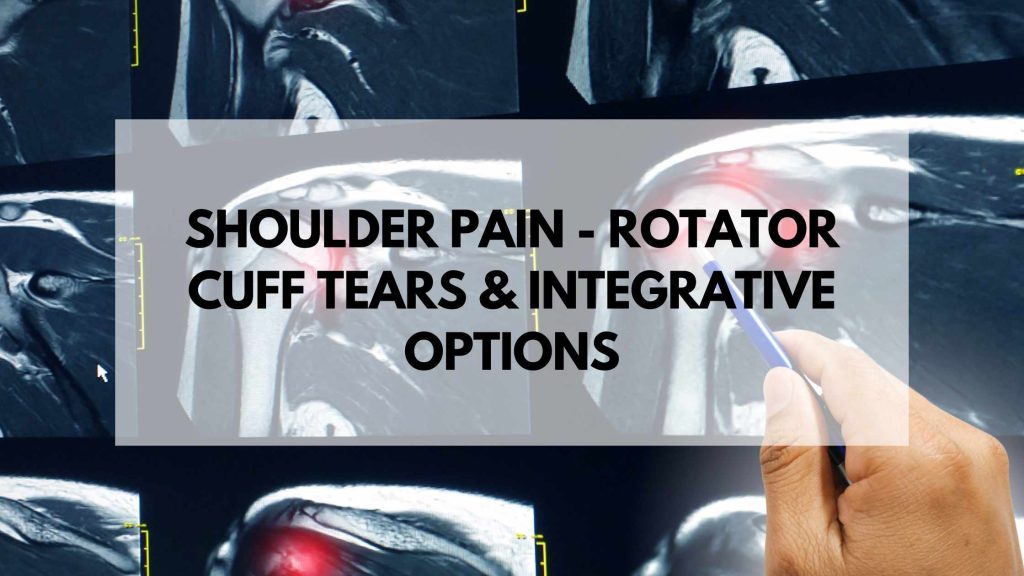Rotator cuff tears can be a painful and debilitating injury, limiting range of motion in the shoulder and causing difficulty with everyday activities. The rotator cuff is a group of four muscles located around the shoulder joint which help to stabilize it during movement. Tears occur when there is damage to one or more of these muscles, resulting in pain and decreased mobility. In some cases, surgery may be necessary for treatment but luckily there are also integrative options available that can provide relief from pain and limited range of motion associated with rotator cuff tears.
What is the rotator cuff?
The rotator cuff is a group of four muscles located around the shoulder joint which help to stabilize it during movement. These four muscles are the supraspinatus, infraspinatus, teres minor and subscapularis. Together, they provide strength and stability to the shoulder joint while allowing for a full range of motion in all directions. The supraspinatus allows abduction of the arm away from the body while also helping with external rotation; the infraspinatus helps with external rotation; the teres minor assists with both internal and external rotation; and finally,the subscapularis helps facilitate internal rotation.
By working together these four muscles allow for a wide range of motion at the shoulder joint while providing stability when needed.
1. Supraspinatus: Abduction of the shoulder
2. Infraspinatus: External rotation of the shoulder
3. Subscapularis: Internal rotation and adduction of the shoulder
4. Teres Minor: External rotation of the shoulder
What causes rotator cuff tears?
- Trauma
- Overuse
- Aging
As we grow older there is a tendency for the rotator cuff tendons to become more fragile and susceptible to injury. Just as your skin wrinkles and your hair turns gray, the likelihood of having a tear increases as you grow older. Why does this occur? As we get older it takes more cellular energy in the form of stem cells to mitigate the normal wear and tear of aging. These cells get old just like us and can’t do their job as well as they were once able to and sometimes need a “boost”.

Check out this chart – by the time we are 50 years old almost 40% of us are going to have asymptomatic rotator cuff tears. This means there are tears on 40 out of 100 people around the age of 50 even if they don’t have any pain at all. The tear might not be the cause of your pain.
What this means is that we can’t simply rely on an MRI to diagnose your pain. You can have a tear and have no pain.
This means we HAVE to perform a thorough physical exam.
In fact over 70% of the innervation of your shoulder joint comes from a single nerve – and if it is irritated then you will have a similar pain presentation to that of a rotator cuff tear. Your suprascapular nerve supplies both motor nerve signals and sensory signals to and from the main rotator cuff muscle where tears are commonly seen (Supraspinatus muscle).

Symptoms of rotator cuff tear
• Pain: One of the most common symptoms of a rotator cuff tear is pain, which can range from mild to severe. The pain may be localized to the shoulder area or radiate down the arm and into the neck or back. It is usually worse with certain activities such as overhead reaching, lifting or carrying objects, or even sleeping
• Limited abduction of the arm away from the body
• Pain and stiffness while performing external rotation
• Decreased range of motion in all directions, including both internal and external rotation
• Pain when lifting or reaching overhead, especially when attempting to reach behind the back
• Difficulty with everyday activities such as putting on a shirt or brushing one’s hair
• Weakness in the shoulder muscles when attempting to lift objects
• Difficulty sleeping on the affected side due to pain and stiffness
What should I do for a rotator cuff tear?
Let me walk you through how I think about rotator cuff tears and shoulder pain. First we know that rotator cuff tears might not even be the cause of your pain even if your imaging shows one and your shoulder hurts. Two we know that rotator cuff tears can heal on their own. Three we know that cortisone injections are actually toxic to tendons and ligaments and cause cause tearing to progress. Four, we know that >75% of rotator cuff surgeries have a re-tear. So what do you do?
First you need a good physical exam to really understand what your tissue is doing. Your regular doctor probably isn’t going to spend the time on this nor do they have any treatment interventions outside of cortisone and surgery. So find a doc like me 😉 who actually have interventions that can stimulate regeneration and healing.
Second, understand that by restoring function to the nerves and muscles that control your shoulder is likely going to make a huge difference in your pain and your functional ability to use your shoulder.
So how do we do that?
A better option for Rotator Cuff Tears
Let’s understand that it’s not just 4 muscles that make your shoulder work.
In total, 17 different muscles attach to the scapula and help to stabilize the shoulder joint. Any and all of these muscles and the nerves that make them function can be a pain generator and/or cause of your pain.
There are 5 ligaments that stabilize your shoulder – again any one or all of these could be a pain generator and cause of your shoulder pain.
So now we have 23 targets (not even including the multiple areas we can affect the nerves that innervate these tissues are).
My favorite tools to use to help shoulder pain and rotator cuff issues.
- Neurofunctional Acupuncture – restore function to irritated nerves and how those nerves control your rotator cuff muscles.
- Dry Needling – target trigger points in the 4 rotator cuff muscles and the additional muscles that stabilize the scapula. Provide a healing stimulus to the 5 ligaments that stabilize the shoulder.
- Prolotherapy + Ozone – a regenerative injection therapy that can help to stabilize the ligaments of the shoulder, tendons that are torn or irritated and the joint capsule itself.
In Conclusion
Your rotator cuff tear might not even be the problem. You can’t simply rely on a MRI alone to determine the best course of treatment. Steroids and surgery are poor options when it comes to long term outcomes.
The good news is there are integrative approaches using neurofunctional acupuncture, dry needling and prolotherapy for rotator cuff tears that can help you get back to feeling your best without limitations from pain or range of motion.
Don’t just take the opinion of a doctor giving you recommendations based on just what your insurance company will pay for. You deserve better.
Related posts:
- Acupuncture for Rotator Cuff Pain
- Treating L5 Disc Herniation – Alternative treatment for disc herniation – A Case Study and Overview of How I treat
- Frozen Shoulder – An Integrative Approach To Treating a Tricky Condition
- Our Cluneal Nerve Treatment Continues to Help People With Chronic Low Back Pain





